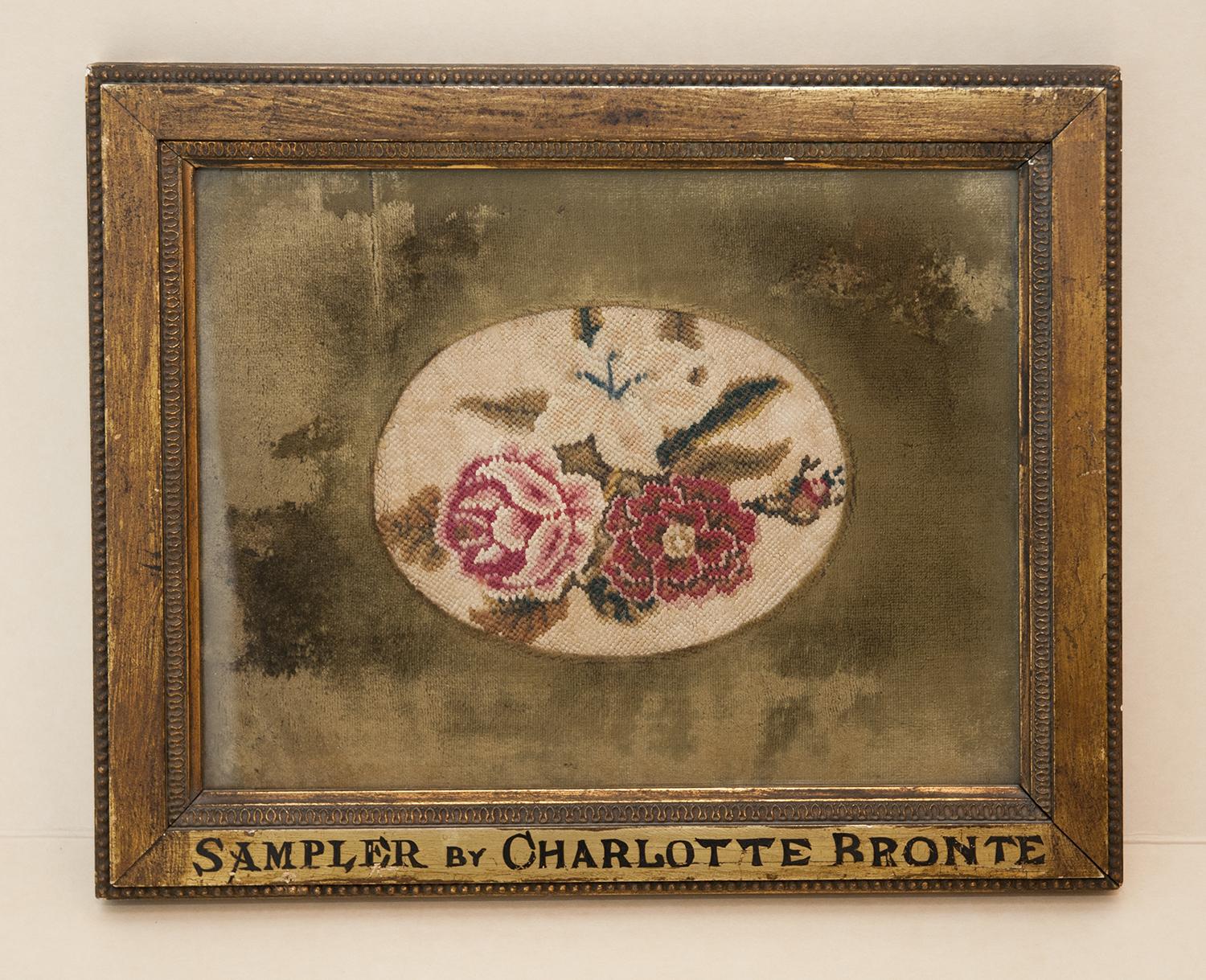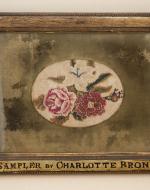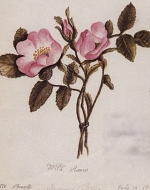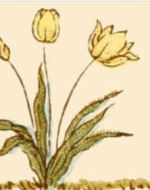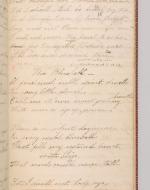Created by Jackie Allaire-MacDonald on Wed, 11/18/2020 - 23:15
Description:
Charlotte, Emily, and Anne Brontë all incorporated flowers into their creative works. Flowers were featured as subjects in the sisters' poems and paintings. They were also used as tools for building setting and sending coded messages in their novels. The sisters displayed a good understanding of floriography, or the language of flowers, in which flowers were assigned a specific meaning in order to be used as a mode of communication. Floriography was popular in Victorian England as a way to convey messages that could not be spoken aloud. Small flower bouquets called “tussie-mussies” were exchanged and could be worn or carried by the recipient.
Needlepoint flowers by Charlotte Brontë, 1840.
This needlepoint flower study by Charlotte Brontë was completed around 1840. It is made of tapestry wool, placed underneath a green velvet mat with an oval opening in the center, and enclosed with a gold-painted wooden frame. The top flower is a white lily, which means “purity and modesty” in the language of the flowers. The bottom left most likely depicts a peony, meaning “shame” or “bashfulness” while the bottom right features a red carnation, meaning “Alas! for my poor heart.” Together the flowers seem to suggest a tension between modesty and shame, perhaps causing the speaker distress.
“Wild Roses,” watercolor by Charlotte Brontë, 1830.
Charlotte created multiple watercolor sketches of roses. Different types and colors of roses have different meanings in floriography, but the meaning of an ordinary rose is “love.”
Anne mentions roses in her writing, including a Christmas Rose in The Tenant of Wildfell Hall (1848), which Helen plucks and presents to Gilbert as an offer of marriage:
'This rose is not so fragrant as a summer flower, but it has stood through hardships none of them could bear: the cold rain of winter has sufficed to nourish it, and its faint sun to warm it; the bleak winds have not blanched it, or broken its stem, and the keen frost has not blighted it. Look, Gilbert, it is still fresh and blooming as a flower can be, with the cold snow even now on its petals. - Will you have it?' (The Tenant of Wildfell Hall by A. Brontë, Chapter 52).
The Christmas rose is a symbol for Helen herself, who has gone through hardships and survived just as the flower has survived the harsh weather. The flower means “tranquilize my anxiety.” By presenting it to Gilbert, Helen is asking him to propose to her.
Detail of "Golden Crocuses," Illustration from Language of Flowers by Kate Greenaway, 1884.
This illustration of golden crocuses comes from a guide to floriography. All three sisters mentioned specific flowers in their novels to add extra layers of meaning to their works. Emily demonstrates her understanding of floriography in Wuthering Heights with the mention of the crocus:
"Mr. Linton had put on her pillow, in the morning, a handful of golden crocuses; her eye, long stranger to any gleam of pleasure, caught them in waking, and shone delighted as she gathered them eagerly together.
‘'These are the earliest flowers at the Heights,’ she exclaimed. ‘They remind me of soft thaw winds, and warm sunshine, and nearly melted snow. Edgar, is there not a south wind, and is not the snow almost gone?’ "(Wuthering Heights by E. Bronte, Chapter 13).
Catherine’s association of crocuses with pleasant weather at her childhood home fits perfectly with the meaning of spring crocuses in the language of flowers, “youthful gladness.”
Manuscript page of "The Bluebell," Anne Brontë’s Collection of Poems 1838 Jan. 24-1841 Aug. 19. From the Henry Houston Bonnell Brontë Collection. Bequest of Helen Safford Bonnell, 1969.
This is a page from a notebook Anne copied her poems into. This page includes the first two stanzas of her poem “The Bluebell.” Anne wrote this poem in 1840 while she was a governess to the Robinsons at Thorp Green, a position that brought her much loneliness and unhappiness. The flower reminds Anne of her joyful childhood, and she mourns the loss of innocence that came with that.
Emily also wrote a poem called “The Bluebell” in 1838. She, too, was working as a governess at the time, at Law Hill, and even more than her sister, disliked this position. Emily's poem is about homesickness. Emily was extremely attached to her home, and in her poem she describes how the familiar flower soothes her. She also mentions heath, which in the language of the flowers means solitude, and the blue violet, which means faithfulness.
Based on the content of their poems, it is likely that both sisters were not actually thinking of the bluebell, which means constancy, but of a different flower, the harebell, which means submission and grief.

